There are countless factors that impact the success of your dental practice. Consumer rights, public policy, health trends. But one of the most influential components that dictates the fate of your practice is the demographics of your patients.
Statistics show that the elderly population in the United States grew at a rate of 15 percent between 2000 and 2010. There is expected to be 92 million elderly individuals by the year 2060.
As people become older, their bodies change. That includes bone structure and gum ridges in the mouth.
Mouths tend to shrink with age, leading to problems such as loose dentures, edentulism, dry mouth related cavities, periodontal disease, and even oral cancer.
In fact, the average age of most patients diagnosed with oral cancer is 62.
As a dentist, it’s worth understanding that many of your older patients are unaware that Medicare does not cover all categories of dental expenses.
Seniors are at risk and underserved in the oral health arena, according to the Journal of American Dental Association.
Elders who can no longer care for themselves, particularly those who live in institutional settings, are the most vulnerable. In 2009, according to the U.S. Department of Health and Human Services, approximately 13 percent of people over age 85 lived in nursing homes, where attention to oral health is believed to be undervalued and often ignored.
A study by researchers at Tufts University supports this claim. It concluded that disabled adults and seniors suffer from an increased number of dental problems due to lack of care and education. Despite the Affordable Care Act and the increased availability of benefits for this at risk group, many seniors are not taking advantage of programs and skipping out on dental care entirely.
So, what can you do to be of better service to this underserved, yet growing, population?
Focus on caregivers
It’s not uncommon for folks to assume that the best way to target an audience is to market to them directly.
But that isn’t always the case.
For elderlies, perhaps the most effective way to reach them is to market directly to their caregivers, instead. That includes not only agencies and homes, but also adults caring for an aging parent.
Part of a caregiver’s job is to keep up with medical and dental appointments. Including that caregiver into your dental digital marketing efforts is essential.
But how do you go about doing that?
Traditional forms of marketing are useful, of course. Handouts provided to nursing homes or agencies is a good place to start.
Don’t be shy about offering adaptive materials. If you notice the signs of poor oral hygiene in an elderly patient, suggest some alternative methods of brushing or adaptive tools for oral care.
If a caregiver is already helping with self-care, he/she may not be skilled at brushing and flossing someone else’s teeth. A quick lesson or suggestion can drastically improve your patient’s health and outcome.
However, we don’t need to remind you that this is becoming an increasingly digital world. Being able to reach caretakers online with targeted messages might very well be your most effective way of offering better care to your geriatric patients.
Targeting this highly specific group online can be a challenge. And, your strategy will change depending on if you target using Google or Facebook.
Let’s start with Google.
Targeting caregivers with Google
When it comes to targeting audiences on Google, you can’t enter a few key demographic factors like you could on Facebook.
You have to use keywords that you believe (or know) your target audience is using.
First you have to recognize that there are several types of caregivers you could target, including:
- Retirement homes
- Independent caregiver agencies
- Adults of aging parents
For our example, let’s home in on the latter, adults of aging parents, as this segment is the least likely to have elderly care information and resources readily available for them.
Your goal here is to compile a healthy list of keywords and key phrases your target audience uses to find information related to your services.
Market research, surveys, and keyword research should help you get started. And while there are incredible tools available to help you craft the perfect keywords, you can conduct some research on your own.
Here’s how we did it.
First, we went to Google and started typing in our most generic key phrase:
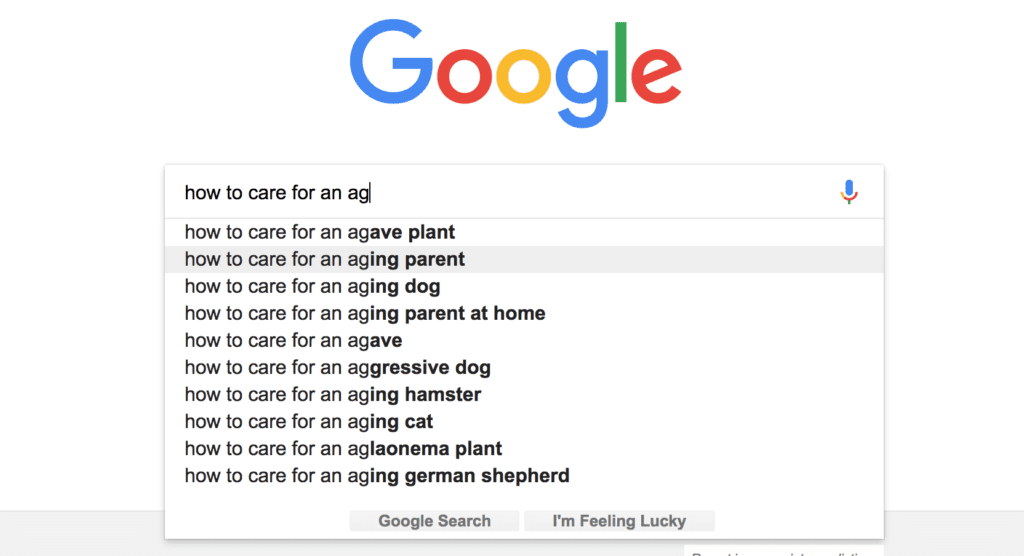
As you can see, our entire phrase popped up before we finished typing the statement. That’s a good sign. That means Google has registered enough like-minded searches to make it part of its autofill feature.
When we click on our desired key phrase, we’re taken to a page with some basic entries, including:
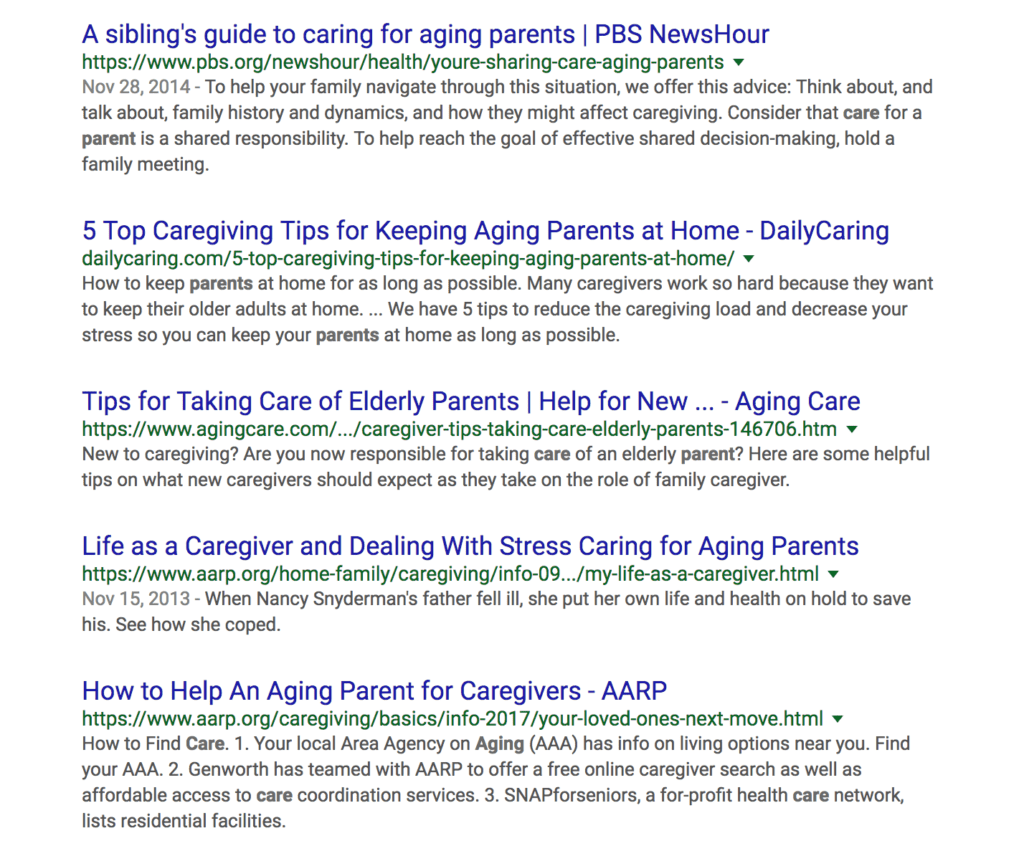
These are all useful entries to research for your own healthcare digital marketing purposes. For example, in a moment we’ll discuss developing a resource center for your practice, focused specifically on elderly dental care. The content found on searches like this one could provide a foundation for what you write about.
But for now, what we’d like to focus on is the related search section typically found at the bottom of Google’s search engine results page:
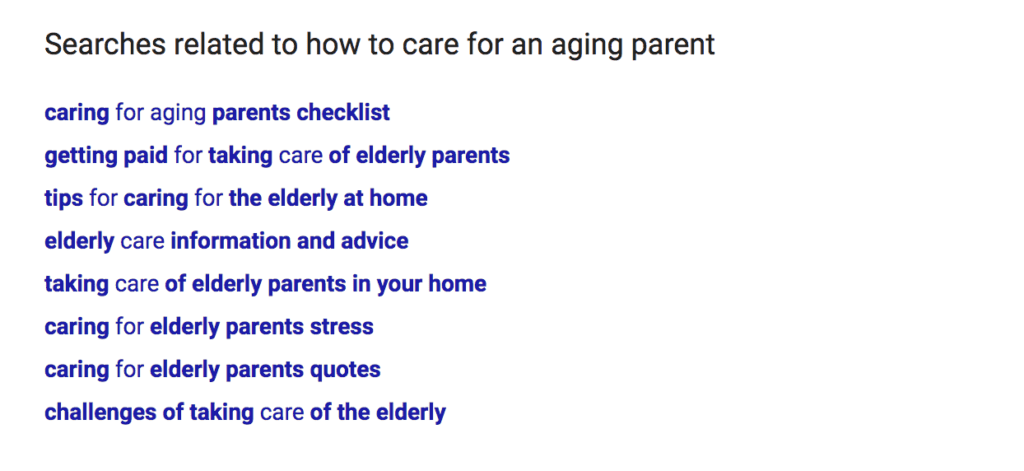
That right there is marketing gold. That related search section is Google’s way of telling you that these are the types of words and phrases people use to find the information related to this subject.
Each time you click on one of those linked list items, you’ll be taken to a new results page, which will also show even more related search terms. Take, for example, what we see when we click on “caring for aging parents checklist”:

Each of these terms are phrases you should consider adding into your keyword list in AdWords. If Google’s telling you that “questions to ask aging parents” is a popular phrase people search, then that’s the type of phrase you want your ads to show up for.
Then the question remains, what type of ad should you produce to target adults caring for aging parents?
In reality, there are many types of ads you can, and should, create, all depending on the specific search phrases used.
In the end, the ultimate goal is to create ad copy that’s related to the search, and is enticing enough to get your audience to click on to your landing page (which we’ll discuss in a moment).
Take a look at the ads that showed up for our initial search:
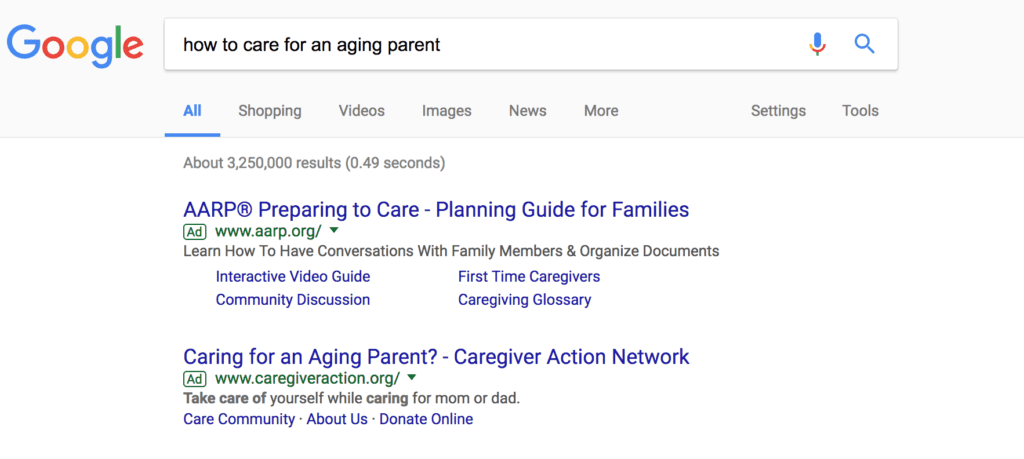
Both ads are extremely relevant to the phrase, how to care for an aging parent.
There is no reason why your ad couldn’t, or wouldn’t, show up here instead. And while your ad could have a dental slant to it, it doesn’t necessarily have to.
Keep in mind folks using this search phrase are looking for general information about caring for an aging parent. While dental care is part of it, it’s not likely top-of-mind for them.
You’d be better off providing general elderly-care information on your subsequent landing page, which then guides folks towards an oral-care slant. We’ll discuss landing pages, and a possible resource center you can use as your marketing hub, in a moment, but first let’s look into marketing on Facebook.
Using Facebook to target adults of aging parents
More often than note, Facebook allows for greater targeting capabilities than Google; but for our specific needs today, Google might prove to be the more useful tool.
That being said, it’s still worth looking into how best to target Facebook users with your message.
If we were targeting nurses, or elderly nursing homes, then yes, Facebook would be an incredible asset. Look at this quick search we did for “retirement home”:
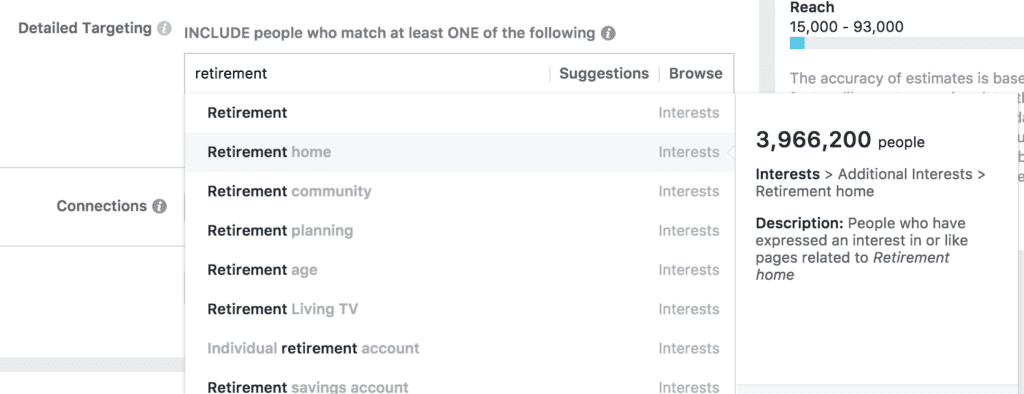
That could prove to be useful. However, that’s not who we’re focused on at the moment. We’re focused on adults of aging parents.
There is no demographic option for that. And while Facebook’s “Life Events” offers a ton of insight (such as if someone just graduated from college or is the parent or someone who has) “aging parent” isn’t a life event option that marketers can target.
So, you have to think creatively. Adults of aging parents are typically:
- Not young, and
- Don’t have young children
You could, then, create an audience on Facebook that targets adults between the ages of 45 and 60, in your specific location. Or, target parents of children who graduated from college. The ad you create will likely be seen by many folks who aren’t in need of your services, or who aren’t caring for aging parents.
However, your ad will also likely be seen by folks who do fall within your ideal target.
Now, the question to ask yourself again is: what kind of ad should I create on Facebook?
We think now is a good time to dive deeper into the world of landing pages and a resource center. Not only will this help you with your Facebook ads, but it’ll also help you as you craft your paid search medical ads for Google.
Creating a resource center as the engine of your ad strategy
Every good ad you create, be it on Facebook or Google, needs to be associated with a relevant and impactful landing page.
Take, for example this ad:

When we click on it, we’re taking to:
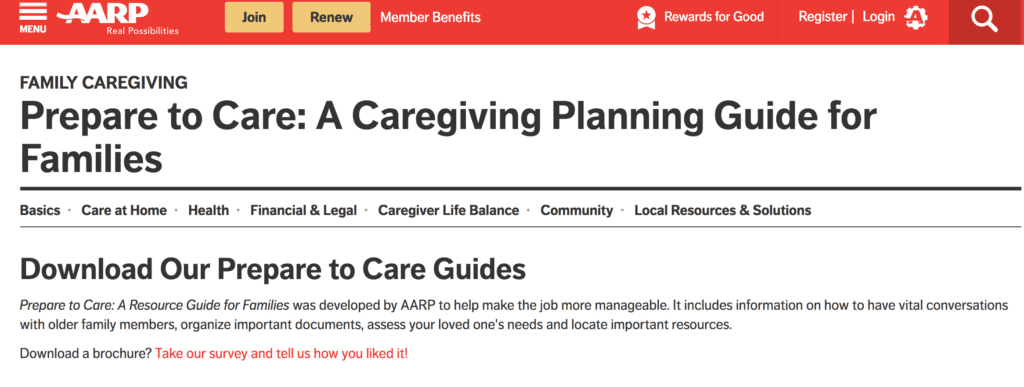
The page goes further than that, but you get the gist. It’s not a terribly powerful landing page, but it does tick off the most important box in your “landing page checklist”: it continues the conversation started in the ad.
In the end, that’s all your landing pages need to do: continue the conversation you started with your ad.
Many folks we know approach advertising this way:
They research keywords, create ads around those keywords, and then develop landing pages for these ads.
We’re going to suggest a different approach:
- Conduct keyword research to identify key terms and phrases (we showed you how to do that all from Google earlier in this article)
- Create a resource center on your website, focused just for elderly dental care, where you publish articles, guides, images, videos and more (using your keyword research from above to determine which content ideas to focus on)
- Create ads for these resources. Feel free to create just one or two at first, then build them out.
Here’s why we suggest this approach:
- The hardest part about advertising is having the content/landing pages to make your ad worthwhile. With our content-first approach, you’ve built out a ton of relevant content. Your ad campaigns won’t be slowed down by the need to create new content.
- You can stop and run ads as often as you’d like. Create two ads to start, focused on two topics you deem the most likely to convert traffic. Then, if they succeed, invest more in them while you launch smaller campaigns for other content pieces in your resource center.
- As you develop your ad campaigns, this content will begin to get indexed by Google. In other words, your resource center will start ranking on Google organically. In some cases, you might find that your ad, and your landing page, will rank on a results page at the same time. That is a very good thing.
To make this approach work for you, we suggest you create a general resource center on your website (this is just a fancy term for “blog”).
This resource center should be broken up into categories, including, for example:
- Elderly dental care
- Oral care for children
- Cosmetic dentistry
- And so on
You would then perform keyword research as we outlined earlier to determine the types of content your prospective patients are searching for.
Create your own content, on your site. Each blog post you create can, and should, be considered a “landing page.” Treat it as such.
Launch ads around these “landing page”, targeting your ideal audience. Again, for the elderly, it’s likely going to be their caregivers.
Monitor your campaigns. Make changes to the content in the ad and landing page. Alter your bidding strategy. Invest more in the ad + landing page combinations that deliver the best rewards.
As you can see, this strategy doesn’t just work for targeting your aging patients; you can use it to target every one of your prospective patients.

